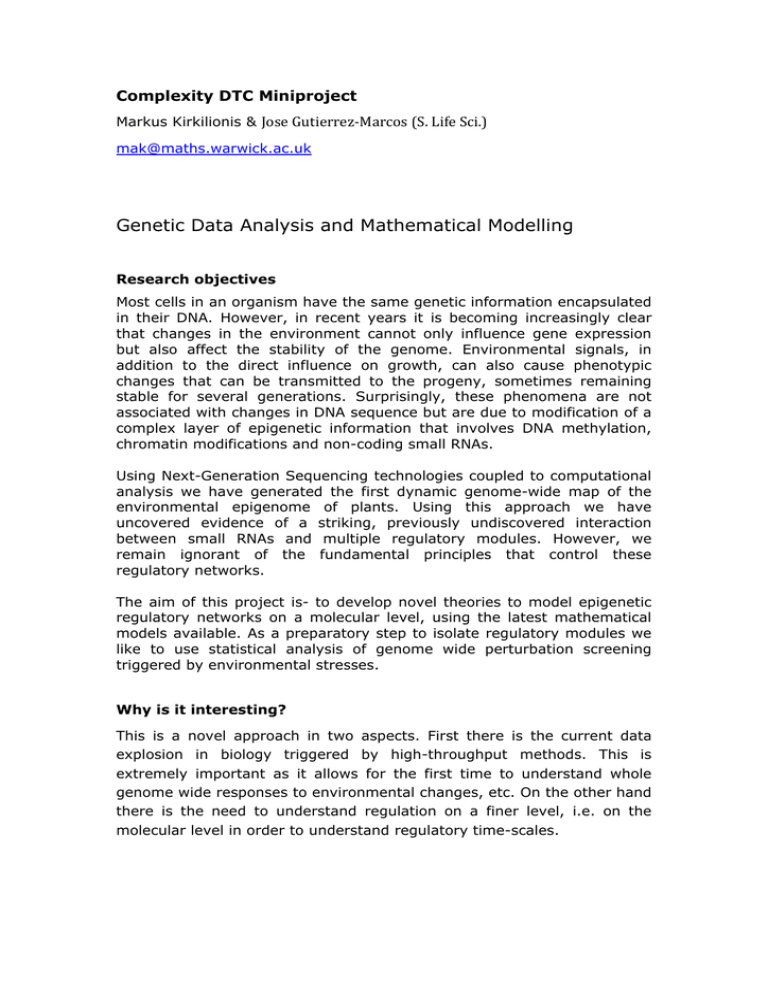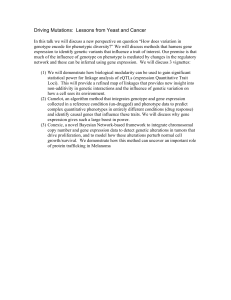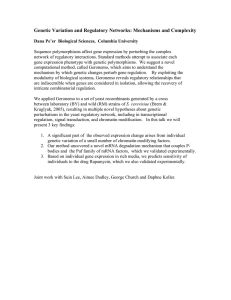Document 13294258
advertisement

Complexity DTC Miniproject Markus Kirkilionis & Jose Gutierrez-­‐Marcos (S. Life Sci.) mak@maths.warwick.ac.uk Genetic Data Analysis and Mathematical Modelling Research objectives Most cells in an organism have the same genetic information encapsulated in their DNA. However, in recent years it is becoming increasingly clear that changes in the environment cannot only influence gene expression but also affect the stability of the genome. Environmental signals, in addition to the direct influence on growth, can also cause phenotypic changes that can be transmitted to the progeny, sometimes remaining stable for several generations. Surprisingly, these phenomena are not associated with changes in DNA sequence but are due to modification of a complex layer of epigenetic information that involves DNA methylation, chromatin modifications and non-coding small RNAs. Using Next-Generation Sequencing technologies coupled to computational analysis we have generated the first dynamic genome-wide map of the environmental epigenome of plants. Using this approach we have uncovered evidence of a striking, previously undiscovered interaction between small RNAs and multiple regulatory modules. However, we remain ignorant of the fundamental principles that control these regulatory networks. The aim of this project is- to develop novel theories to model epigenetic regulatory networks on a molecular level, using the latest mathematical models available. As a preparatory step to isolate regulatory modules we like to use statistical analysis of genome wide perturbation screening triggered by environmental stresses. Why is it interesting? This is a novel approach in two aspects. First there is the current data explosion in biology triggered by high-throughput methods. This is extremely important as it allows for the first time to understand whole genome wide responses to environmental changes, etc. On the other hand there is the need to understand regulation on a finer level, i.e. on the molecular level in order to understand regulatory time-scales. Markov chain of gene states s Birth-death process of gene products x active states degradation degradation transcription translation mRNA transitions are binding events of regulatory factors (gene products) protein gene products regulate gene activity inactive states Master equation adiabatic limit continuum limit Fokker-Planck equation in concentrations of gene products x; defines vector fields invariant measures μs fs average dynamics dx/dt = ∑ μs⋅fs Prospective deliverables. - Statistical analysis of high-throughput data. - Markov chain based mathematical models of genetic regulation including regulation by microRNA. Who should benefit from this research? - Complex systems scientists - Biologists, mostly geneticists. Outline of avenues for a follow-up PhD project. This mini-project is perfectly suited for a full PhD research project, although the student will need a good background in maths/computation. A successful project will provide novel concepts in gene regulatory networks. We will use the statistical analysis of high throughput data to isolate genetic modules, and then subsequently model them mechanistically, with the methods described in [1] and [2]. We will introduce regulation by microRNA as another theoretically mostly yet unexplored level of regulatory fine tuning. References: [1] Kirkilionis, M., Janus, U. and Sbano, L. (2011a) Multi-scale genetic dynamic modelling I : an algorithm to compute generators. Theory Biosci, DOI http://dx.doi.org/10.1007/s12064-01 1- 0125-0 [2] Kirkilionis, M., Janus, U. and Sbano, L. (2011b) Multi-scale genetic dynamic modelling II: application to synthetic biology : An algorithmic Markov chain based approach. Theory Biosci, DOI http://dx.doi.org/10.1007/s12064-011-01 26-z [3] Molinier J et al. (2006) Transgeneration memory of stress in plants. Nature 442:1046-­‐9








